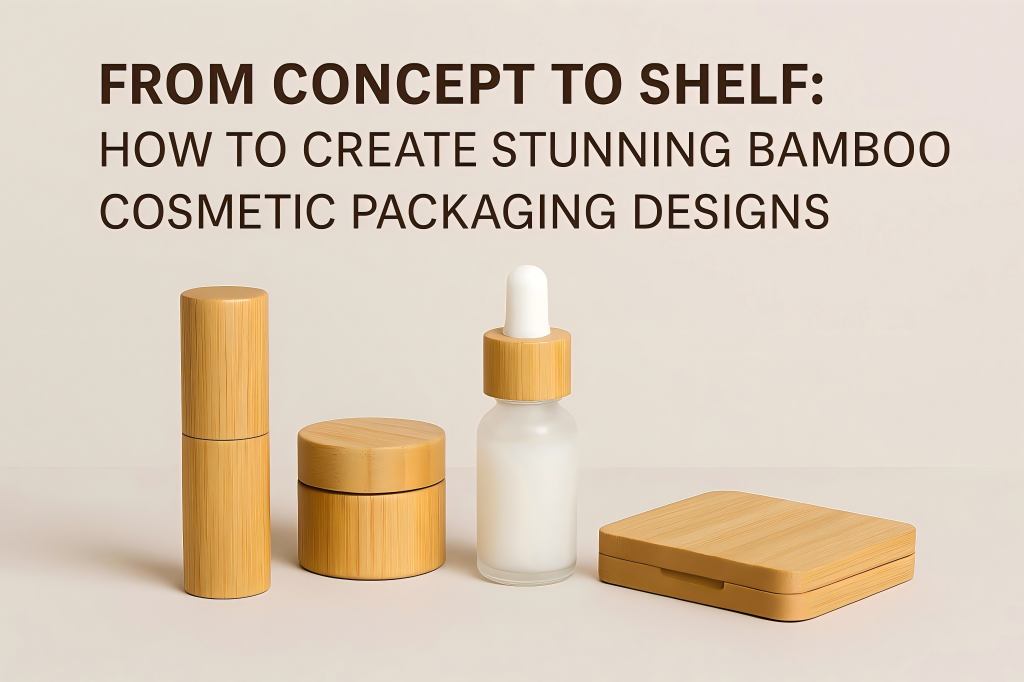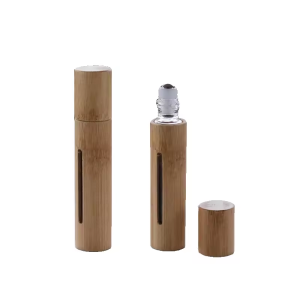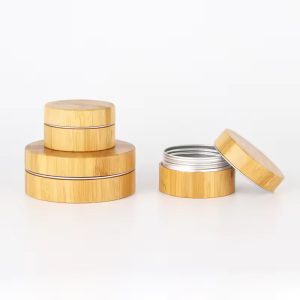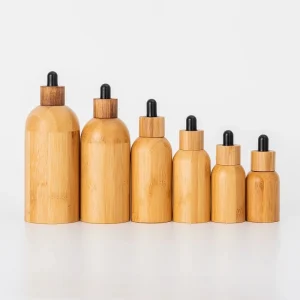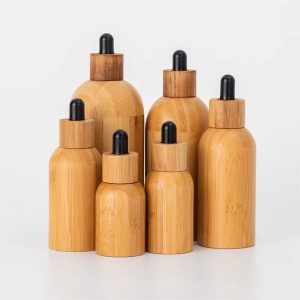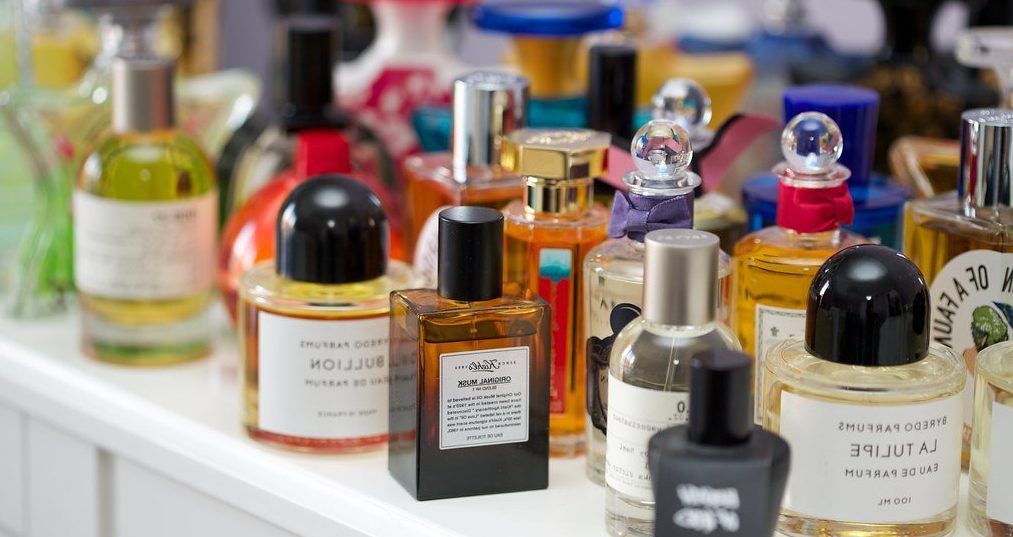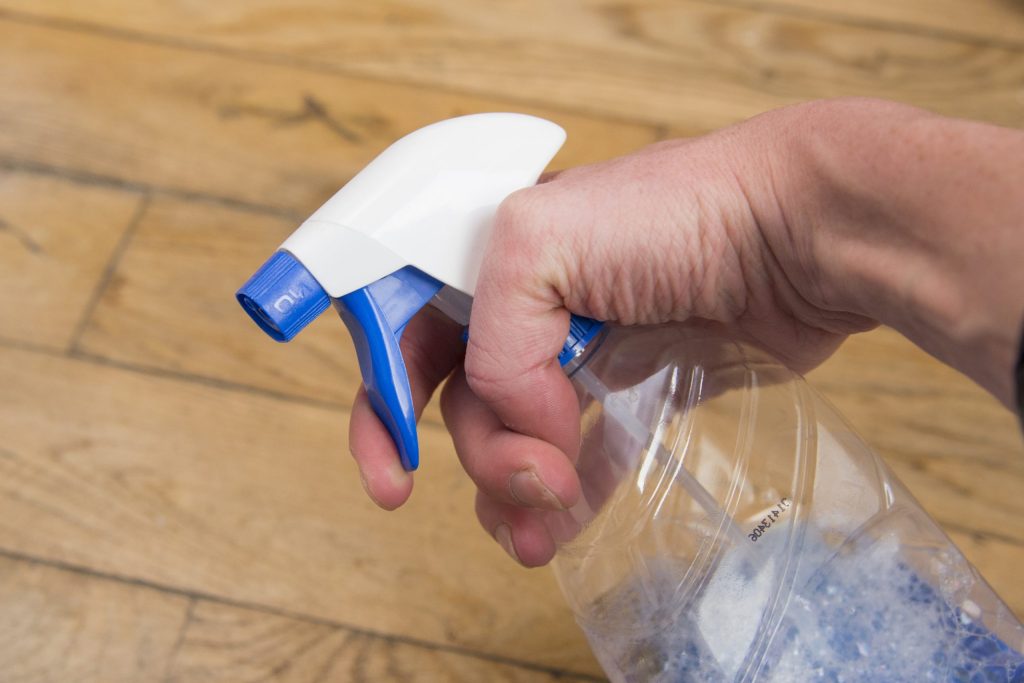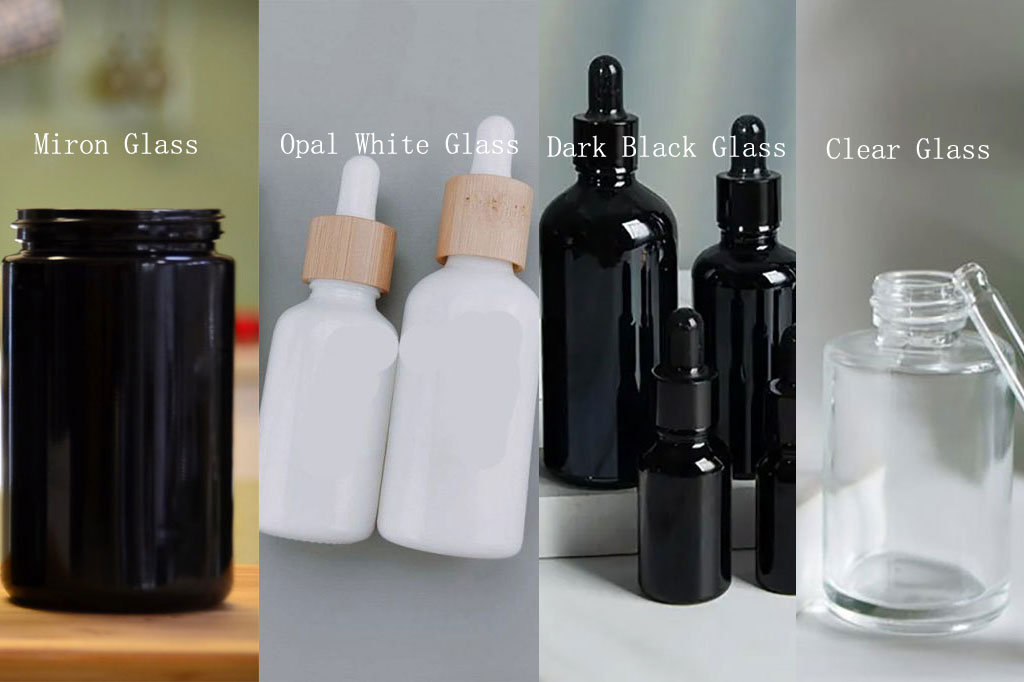In the ever-evolving world of cosmetics, where product presentation is as vital as performance, packaging has become a critical element in defining brand identity and consumer appeal. Among the many emerging sustainable materials, bamboo has captured the attention of designers and eco-conscious brands alike. Its unique combination of natural beauty, renewable origins, and versatile form makes it a powerful symbol of environmental responsibility and luxury aesthetics.
The Rise of Bamboo in Cosmetic Packaging
Due to customer demand for environmentally friendly products and company pledges to cut back on plastic waste, the cosmetics sector has entered a new era of sustainability. An excellent alternative is bamboo, one of the renewable resources with the quickest rate of growth on the planet. It doesn’t need dangerous chemicals or pesticides to grow, can be harvested in three to five years, and regenerates without replanting.
Unlike plastic or glass, bamboo provides a tactile, organic feel that instantly communicates authenticity and nature. Its texture and grain patterns make every piece unique, allowing brands to stand out with packaging that embodies both elegance and environmental ethics. From lip balm tubes to compact cases and skincare jars, bamboo packaging has evolved from a niche trend to a mainstream design statement.
The material’s increasing popularity also stems from its alignment with the clean beauty movement. Consumers no longer judge products solely by their formulations but by the full lifecycle of their packaging. Bamboo not only meets these ethical expectations but enhances the sensory experience of using a cosmetic product—adding warmth, craftsmanship, and a sense of connection to nature.
Understanding Bamboo as a Design Material
To design successful bamboo cosmetic packaging, it’s crucial to understand the material’s properties. Bamboo is lightweight yet strong, biodegradable, and naturally antimicrobial. Its durability makes it suitable for products that require protection against impact, while its natural surface can be finished in multiple ways—from smooth matte coatings to polished, glossy appearances.
However, working with bamboo also comes with unique design challenges. Unlike synthetic materials, bamboo has a variable texture and natural imperfections that require precise engineering and finishing to achieve consistency. Moisture resistance is another consideration, as bamboo must be properly treated and sealed to prevent swelling or cracking, especially in humid environments.
Designers must collaborate closely with material engineers to ensure each product not only looks beautiful but functions effectively. The result is a perfect harmony between sustainability, form, and performance.
The Concept Stage
Every great packaging design starts with a clear concept. In the case of bamboo cosmetic packaging, the concept must capture the essence of the brand and the lifestyle it represents.
Is the brand minimalist and modern, or rustic and artisanal? Is the focus on luxury skincare or playful everyday beauty? The answers to these questions guide the creative direction of the packaging design.
A strong concept connects aesthetics with storytelling. For example, a brand emphasizing wellness and natural living might draw inspiration from bamboo forests, using soft green tones and organic shapes. A high-end cosmetic label, on the other hand, might favor a sleek, polished bamboo surface with metallic accents to evoke sophistication.
Mood boards, material samples, and digital renderings help visualize these ideas. Early prototypes can test different design variations, allowing teams to explore the balance between visual appeal, sustainability, and functionality.
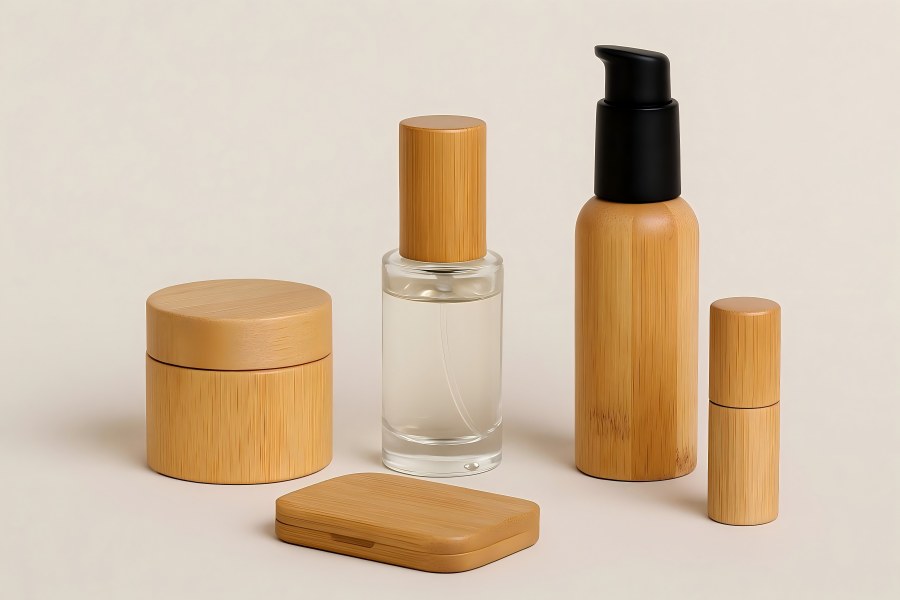
Design Development: Balancing Beauty and Function
Development follows concept definition in the design process. This stage involves detailed considerations such as structural integrity, product compatibility, and user experience.
a. Structural Design
Bamboo can be shaped into multiple forms—cylindrical lipstick tubes, compact powder cases, cream jars, or dropper bottles. Structural design focuses on achieving precision and durability. Designers must account for the mechanical behavior of bamboo when used in conjunction with inner linings or closures, often made from glass, aluminum, or recyclable plastics.
For refillable products, modular designs are preferred. A bamboo outer casing with a replaceable inner cartridge allows customers to keep the main container while simply replacing the product insert, minimizing waste.
b. Ergonomics and User Interaction
Aesthetic appeal is only half the equation; packaging must feel good in the user’s hands. Bamboo’s warmth and texture give it a natural ergonomic advantage. Designers often contour the shape to ensure a comfortable grip, especially for handheld products like lipsticks or serums.
c. Visual Detailing
Laser engraving, embossing, or silk-screen printing are popular techniques for branding bamboo surfaces. These methods preserve the eco-friendly nature of the material while allowing for elegant logo placement and decorative patterns. Natural finishes, combined with minimalist typography, create a timeless appeal that aligns perfectly with sustainable luxury branding.
Material Sourcing and Sustainability Standards
Sourcing plays a vital role in the authenticity of bamboo cosmetic packaging. Not all bamboo is created equal; variations exist in density, color, and environmental footprint. Ethical brands ensure their bamboo comes from sustainably managed plantations certified by credible organizations.
To further enhance environmental responsibility, designers can integrate other natural materials—like cork, rice husk composites, or biodegradable resin inserts. Combining materials strategically can enhance functionality without compromising sustainability.
Additionally, minimizing transportation emissions through local sourcing or regional manufacturing can further reduce the carbon footprint of the packaging.
Engineering and Manufacturing: Turning Design into Reality
Transforming a bamboo concept into a mass-produced packaging solution requires precision and collaboration between designers, engineers, and manufacturers.
a. Cutting and Shaping
Bamboo is typically processed into thin sheets or blocks before being carved or turned into cylindrical shapes using CNC machinery. The manufacturing process must account for bamboo’s natural grain direction to prevent cracking during machining.
b. Finishing and Coating
Finishing touches are crucial for longevity and appearance. Water-based coatings or plant-based lacquers are often applied to protect the bamboo from moisture and enhance its sheen.
Different finishes evoke different brand identities:
- Matte finish: Natural, organic, minimalist look.
- Gloss finish: Luxury, polished appeal.
- Carbonized finish: Deep brown tone that adds warmth and sophistication.
c. Integration with Other Components
Many cosmetic products require a hybrid design, where bamboo is combined with other materials for sealing or dispensing mechanisms. For instance, a bamboo lipstick case may include an aluminum inner tube, or a bamboo lotion pump may have a recyclable plastic nozzle. The key is to minimize non-biodegradable components and ensure each material can be easily separated for recycling.
Branding Through Bamboo
Bamboo packaging allows brands to express values beyond surface aesthetics. It communicates a commitment to sustainability, craftsmanship, and mindfulness. The tactile experience of bamboo adds emotional depth to the unboxing moment—an increasingly vital aspect in digital marketing and social media branding.
Brands often capitalize on this by highlighting the origin story of their packaging—emphasizing renewable sourcing, handcrafted finishes, and biodegradable features. The visual storytelling around bamboo packaging strengthens brand identity, transforming packaging from a mere container into a symbol of the brand’s ethos.
Table 1: Branding Attributes of Bamboo Cosmetic Packaging
| Attribute | Description | Consumer Impact |
| Sustainability | Renewable, biodegradable, eco-conscious | Builds trust and brand loyalty |
| Aesthetics | Natural grain patterns, warm tones | Enhances product luxury and uniqueness |
| Tactility | Smooth yet organic feel | Improves user satisfaction |
| Authenticity | Aligns with natural and wellness themes | Appeals to conscious consumers |
| Storytelling | Symbol of nature and balance | Strengthens emotional engagement |
Prototyping and Testing
Before launching a full production line, prototypes are essential. These early samples test the structural strength, surface finish, and functional elements of the design. They also allow for user testing—gauging how consumers interact with the product, how easily it opens, and whether it conveys the intended brand image.
Testing extends to environmental conditions as well. Bamboo must withstand variations in humidity and temperature during storage and transport. Seal integrity, especially for liquid or cream-based cosmetics, is crucial to prevent leakage or contamination.
By refining the design through iterative testing, brands can ensure that the final product not only meets aesthetic expectations but performs flawlessly throughout its lifecycle.
Packaging Optimization
For commercial success, bamboo packaging must balance sustainability with scalability. The production process ought to be optimized in order to reduce manufacturing expenses and material waste. Techniques such as precision cutting and modular design systems help achieve consistency while reducing excess.
Brands can also explore multi-use designs, such as bamboo jars that double as travel containers or refillable compact cases. These strategies enhance customer value while reducing overall packaging waste.
Furthermore, scalable manufacturing ensures that eco-friendly packaging remains accessible to both boutique brands and global enterprises. When executed efficiently, bamboo packaging can compete with plastic in both cost and performance.
Bringing It to Market
When a bamboo-packaged cosmetic product finally reaches the retail shelf, it must instantly capture consumer attention. Shelf appeal is shaped by three main factors—visual distinction, brand consistency, and emotional connection.
The warm tones and organic beauty of bamboo naturally stand out in a sea of synthetic packaging. Minimalist designs with clean typography, natural color palettes, and subtle textures reinforce the eco-luxury aesthetic.
Digital marketing also plays a crucial role. High-quality visuals showcasing bamboo textures and sustainable stories attract online consumers who value ethics as much as elegance.
Case Applications
Bamboo’s versatility makes it suitable across multiple product categories:
| Product Type | Example Design Features | Functional Considerations |
| Lipsticks | Cylindrical bamboo cases with metal inner tubes | Smooth twist mechanism, refillable options |
| Face Creams | Bamboo jars with glass or resin inserts | Airtight seals, reusable container |
| Perfume Bottles | Bamboo caps or sleeves | Precision fit, moisture resistance |
| Serum Droppers | Bamboo collar with glass pipette | Hybrid component design |
| Compact Powders | Magnetic bamboo cases | Replaceable inserts, mirror integration |
This diversity allows bamboo packaging to serve as a unifying brand material across product lines, reinforcing identity and sustainability values.
Future Trends and Innovations
The future of bamboo cosmetic packaging is bright and innovative. As technology advances, we can expect even more efficient processing methods, improved moisture protection, and creative hybrid designs.
Emerging trends include:
- Refillable ecosystems: Promoting container reuse or returns by consumers.
- Smart packaging integration: QR codes embedded on bamboo surfaces linking to sustainability information.
- Zero-plastic systems: Fully compostable packaging using bamboo and plant-based adhesives.
- 3D customization: Personalizing bamboo patterns or shapes for exclusive collections.
These innovations demonstrate that sustainability and luxury are no longer opposites—they coexist beautifully through intelligent design.

